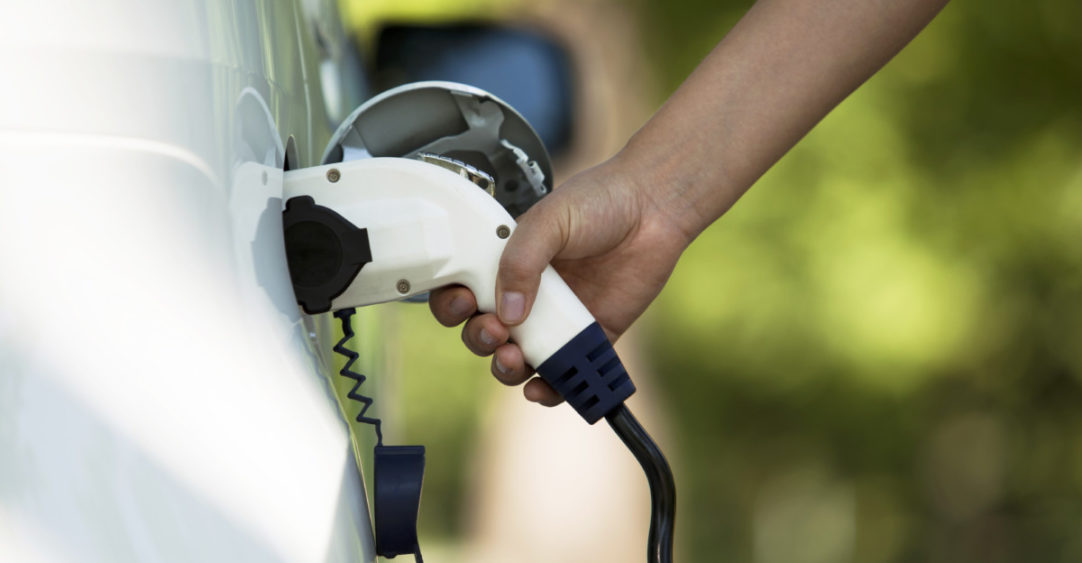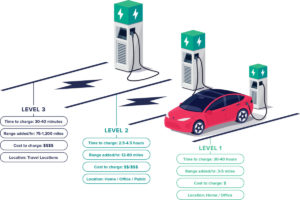
Electric Vehicle Charging Stations 101
Introduced more than 100 years ago, electric vehicles have seen a rise in popularity today for many of the same reasons they were first popular. Whether it’s a hybrid, plug-in hybrid, or all-electric, the demand for electric drive vehicles has continued to climb as prices drop and consumers look for ways to save money at the pump. In this series, readers can expect to gain an understanding of the applicable codes and standard design practices for integration of electric vehicle supply equipment (EVSE) in building electrical systems.
Before we dive into the technical content, I want to provide a brief overview of what defines an electric vehicle, some of the contributors to their rise in popularity, and explain the different types of charging stations.
What is an electric vehicle?
As defined by the Environmental Protection Agency (EPA), “Electric vehicles (EVs) have a battery instead of a gasoline tank, and an electric motor instead of an internal combustion engine. Plug-in hybrid electric vehicles (PHEVs) are a combination of gasoline and electric vehicles, so they have a battery, an electric motor, a gasoline tank, and an internal combustion engine. PHEVs use both gasoline and electricity as fuel sources.” There are dozens of electric vehicles on the market, plus many more when you include hybrid and plug-in hybrids. Some of the most popular models come from Tesla (the Model Y, 3, and X), not to mention the Nissan Leaf and Chevrolet Bolt. Additionally, many manufacturers are releasing an electric or hybrid version of their most popular models (like the Ford Mustang Mach-E and F-150 Lightning, BMW x5, and Toyota Corolla).
Why are electric vehicles gaining in popularity?
By 2025, it is expected that 10% of all new-car sales will be electric vehicles and will pass sales of gas-powered cars sometime in the 2030s. This rise in popularity can be attributed to multiple factors:
- Skipping the gas station. As gas prices continue to increase (average $3.20/gallon Oct 2021), the appeal of skipping the weekly gas station visit is growing.
- Savings in operations and maintenance. There are no oil changes, no smog or emissions tests, and fewer parts to wear out or break over the life of the car.
- Environmental impact. Electric vehicles produce zero emissions. The reduction in transportation-related greenhouse gas emissions helps reduce our carbon footprint and improve air quality for everyone.
- Continuous improvements. Year after year, electric vehicles are constantly improving, from mileage range, faster charge times, comfort, and performance.
- Tax credits. New electric and plug-in hybrid vehicle purchases can be eligible for federal tax credit of up to $7,500. Similar incentives may be offered by state and local governments or local electric utility providers for new EVs and/or charging equipment.
- Consumer satisfaction. Instant-torque, comfortable & quiet driving experience, and lower ongoing costs. For many new EV owners, the common sentiment is “why didn’t I go electric sooner?!”
Where and how is an electric vehicle charged?
There are three levels of electric vehicle charging: Level 1, Level 2, and Level 3.

Level 1 charging uses a common 120-volt receptacle outlet and can be suitable for overnight or workplace charging. Every electric or plug-in hybrid vehicle can use Level 1 charging by plugging the charging equipment (typically a portable unit provided with the vehicle) into a standard three-prong wall outlet. Level 1 adds between three and five miles of range per hour and is the slowest way to charge, often referred to as “trickle-charging.” Level 1 charging can be easily provided at private residences and office buildings from 120V convenience receptacles located near designated parking spots.
Level 2 charging stations require a dedicated electrical connection and are most suitable for providing a full charge in a few hours. Level 2 charging equipment is typically supplied with a dedicated circuit at 208V or 240V, with circuit breaker rating ranging from 40-100 amps. Level 2 can charge much faster than Level 1, adding between 12 and 80 miles of range per hour depending on the power output of the Level 2 charger and the vehicle’s maximum charge rate. Level 2 charging stations account for >80% of public EVSE ports in the United States, and are often installed at private residences, office buildings, and in public locations like shopping centers, parking garages, and other destinations with expected dwell times of a few hours.
Level 3 (also called DC Fast Charge & Supercharging) is the quickest type of charging station available for consumer vehicles today. Unlike Level 1 and Level 2 charging, Level 3 charging typically uses a 480V, three-phase power supply and bypasses the vehicle’s onboard charger to provide direct current (DC) at a much higher rate. They can add between three to 20 miles of range per minute, bringing most EV batteries back up to 80% charge in 30 minutes. For these reasons, Level 3 charging stations are commonly located near transportation routes and not found in private residences.
It is important to note that all electric vehicles sold in the United States use the same J1722 connector for Level 1 and Level 2 charging, often called the “J-plug.” There are three standards for Level 3 charging: a Tesla proprietary plug, CHAdeMO (the Asian standard), and Combined Charging System, CCS or “Combo” plug.

Electric Vehicle Charging Station series links:
Electric Vehicle Charging Stations 101
Design Considerations for Electric Vehicle Charging Stations
Designing EV Charging Station Infrastructure
Building Sustainability with Electric Vehicles
The Future Impact of Electric Vehicles on Transportation Planning
Do you have questions about electric vehicle charging stations? Don’t hesitate to reach out to SSR for our guidance and expertise. Email info@ssr-inc.com and someone will promptly follow up.







